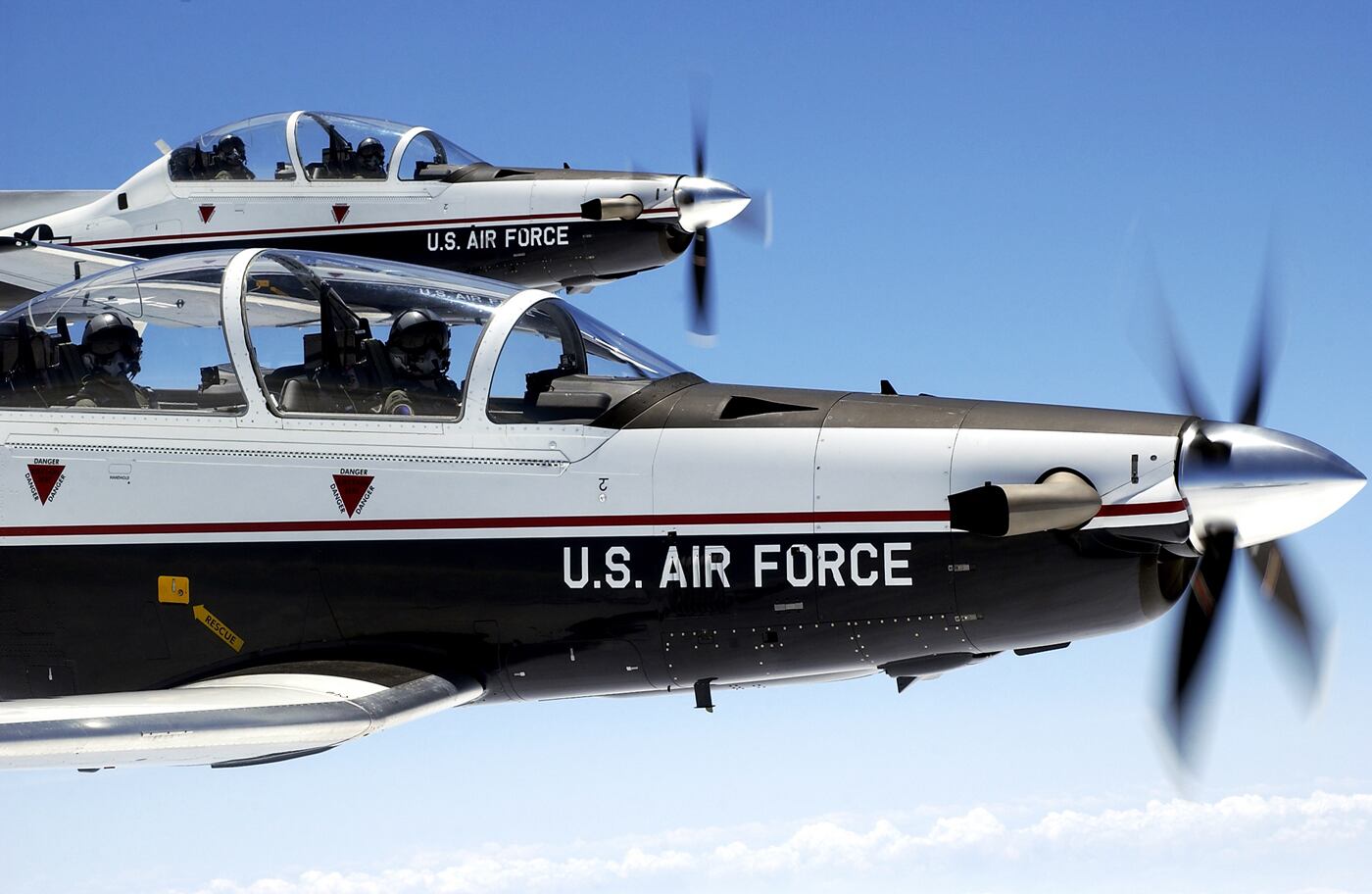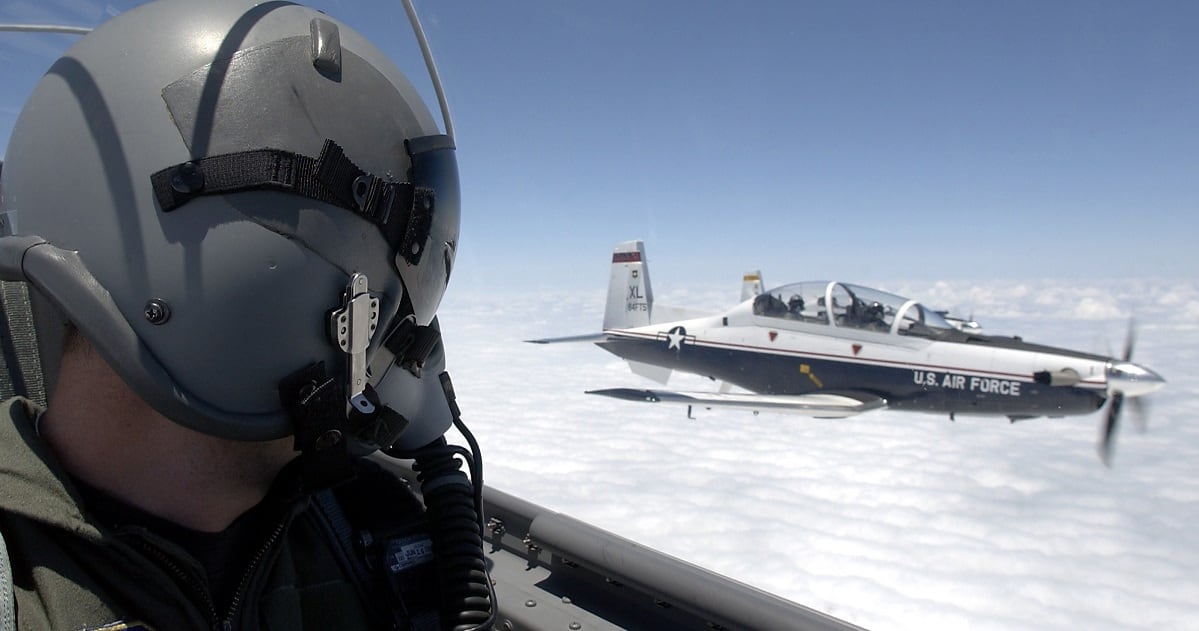The Air Force cut the number of hypoxia and similar incidents in the T-6A Texan II by more than half in fiscal 2019 after putting into place a series of changes it hoped would fix the problem.
But the Air Force pilots still recorded 41 hypoxia-like incidents in the crucial trainer aircraft last year, according to data provided at Air Force Times’ request. That was by far the highest number of individual incidents compared with other aircraft platforms across the fleet, and also meant the T-6 had the Air Force’s second-highest hypoxia rate per-100,000 flying hours.
The Air Force experienced a rash of incidents involving hypoxia — a condition caused by a lack of oxygen in the blood, which can sometimes cause shortness of breath, dizziness or a loss of consciousness, and can be extremely dangerous or fatal for pilots — and similar conditions among pilots flying T-6s during fiscal 2018. That year, T-6 pilots alone experienced 89 hypoxia-like incidents, the vast majority of the 135 such incidents across the Air Force’s fleet in 2018.
The frequency of the incidents set off alarm bells across the Air Force and led to several groundings that year — including a month-long grounding of the entire T-6 fleet at one point. The Air Force spent months searching for the problem’s cause, and ultimately concluded that rapidly fluctuating oxygen concentrations were the culprit.
But in a March 5 interview at the Pentagon, Brig. Gen. Gregor Leist, the lead for the Air Force Physiological Action Team, said the Air Force still has a lot more work to do.
“The problem’s not solved, clearly,” Leist said. “We think that [fixing] the breathing systems, especially hygiene and maintenance, has resulted in reduced rates, but not entirely eliminated the problem. And that’s why we continue to explore areas” to further improve how the T-6 delivers oxygen to pilots.
The progress made so far, Leist said, has come from a sweeping overhaul of maintenance practices and technical orders, as well as engineering tweaks to the plane’s oxygen system. The Air Force also took several cues from how the Navy maintains its planes’ oxygen systems, and has come to agree with the Navy’s conclusion that not one, but several factors cause hypoxia problems.
For example, the Air Force has drastically increased the frequency it replaces oxygen concentrators in the T-6. The concentrators are the heart of the On-Board Oxygen Generating System, or OBOGS — a “molecular sieve” that concentrates oxygen and flows it into the aircrew’s breathing systems, AFPEAT director and physician Col. William Nelson said at the Pentagon.
Previously, the Air Force typically flew those concentrators for their entire service life span of about 4,000 hours, Leist said. But now, the Air Force is replacing them after just 600 hours.
“Some of these items were originally designed as ‘fly-to-fail,’” Leist said. With the more frequent replacements, “you’re getting a more consistent, right-in-the-middle-of-the-service life performance, as opposed to flying it until it starts to degrade.”
The Air Force also increased the frequency at which it purges moisture from the OBOGS system. The Navy’s experience operating aircraft at sea revealed the risk of excessive moisture buildup causing hypoxia problems, and passed that lesson on to the Air Force, Leist said.
Another contributing factor: Throttling down the relatively lower-power engine in the T-6, as compared to fighter such as the F-15E Strike Eagle. Pilots flying the Strike Eagle, which has a lot more power fueling its oxygen system, recorded four hypoxia-like incidents in 2018, and just one last year.

But when the T-6′s smaller engine is throttled back to lower power at medium to high altitudes, its OBOGS may not operate as effectively as the Air Force would like, Leist said.
“The big difference between the MSOGS [Molecular Sieve Oxygen Generating System] in the Strike Eagle and the OBOGS in the T-6 is really the engine power that’s available to drive the system,” Leist said.
To fix that problem, the Air Force raised the idle speed of the T-6. That way, its engine can’t be throttled down as much, and enough power keeps flowing to the OBOGS.
| Hypoxia-like events | |||||||||
|---|---|---|---|---|---|---|---|---|---|
| F-22A | F-15C/D | F-15E | F-16C/D | A-10C | F-35A | T-38C | T-6A | Totals | |
| FY18 | 4 | 7 | 4 | 17 | 5 | 4 | 5 | 89 | 135 |
| FY19 | 4 | 10 | 1 | 8 | 2 | 3 | 4 | 41 | 73 |
| Total | 8 | 17 | 5 | 25 | 7 | 7 | 9 | 130 | 208 |
But the Air Force is still working on some longer-term solutions.
An improved version of the OBOGS is still in the works, Leist said. The so-called enhanced OBOGS is designed to produce a more consistent level of oxygen, which he hopes will go a long way to correcting the fluctuations that caused the wave of hypoxia incidents in 2018.
And unlike the old OBOGS, the new system will be able to collect detailed performance data in-flight. That data will allow the Air Force to run diagnostics and find out how much oxygen it was actually producing if something goes wrong in a flight, and help diagnose the problem in a particular plane.
RELATED

The design on the enhanced OBOGS is now complete, Leist said, and the Air Force is moving to the acquisition and production phases. He hopes to field it and begin installing them in T-6s sometime in 2021.
Leist hopes that the new system will further bring down hypoxia rates in the T-6, though he acknowledged it probably will never get down to zero.
“We’re operating humans and machines in a very perilous environment, and there will always be equipment failures, even with the best of maintenance practices,” Leist said. “We believe the current rates are unacceptable, though. That’s why we continue to research and develop remedies toward reducing those rates.”
| Hypoxia-like events (rates per 100K flight hours) | |||||||||
|---|---|---|---|---|---|---|---|---|---|
| F-22A | F-15C/D | F-15E | F-16C/D | A-10C | F-35A | T-38C | T-6A | Total | |
| FY18 | 10.41 | 17.91 | 6.48 | 8.62 | 6.52 | 23.84 | 4.85 | 55.83 | 19.49 |
| FY19 | 14.57 | 24.17 | 1.55 | 4.17 | 2.56 | 15.43 | 3.98 | 23.77 | 10.49 |
| Total | 12.14 | 21.13 | 3.96 | 6.43 | 4.52 | 19.33 | 4.42 | 39.17 | 14.98 |
Nelson said the Air Force and Navy are developing sensors that will go in air crew’s breathing masks, that can record exactly how much oxygen and carbon dioxide they’re getting. And if a physiological event happens, that data will help the Air Force accurately diagnose what happened. Those sensors have been in the works for a few years at the Air Force Research Laboratory’s 711th Human Performance Wing and the Naval Medical Research Unit-Dayton, both at Wright-Patterson Air Force Base in Ohio, Nelson said.
Leist said the Air Force is using rapid acquisition authorities granted by Congress to speed up the process for creating these new sensors.
“That combination of sensors — knowing what the human is experiencing and what the aircraft is producing to support that human — is really the next step in understanding .... this particular issue,” Leist said.
And the Air Force has multiple ongoing studies involving pulmonary medicine and respiratory physiology to better understand what’s causing physiological episodes and how to lessen their effects or stop them, Nelson said.
This includes studying how best to position rescue gear or looking for ways to make it lighter, so it’s not pushing as hard on pilots’ chests and making it harder to breather.
But the Air Force also has to be careful that as it solves one problem, it doesn’t inadvertently create another, Nelson said. For example, he said, what if moving one piece of gear from the chest to the leg increases the risk of it catching on the cockpit as a pilot ejects?
Other air frames also experienced multiple hypoxia-like events in recent years. Pilots flying the F-15 C and D air frames, for example, recorded 10 physiological episodes in 2019, or about 24 for every 100,000 flight hours.
That’s likely due to the advancing age of the Eagle, Leist said.
“Some of the air frames are not quite as straight as they used to be,” Leist said. “So you’re seeing a few more cockpit depressurization issues in the F-15 C and D.”
Replacing the aging longerons of F-15Cs and Ds will help make depressurization less of an issue, he said. And F-15 maintainers are paying closer attention to the Plexiglass seals on the cockpit.
Stephen Losey is the air warfare reporter for Defense News. He previously covered leadership and personnel issues at Air Force Times, and the Pentagon, special operations and air warfare at Military.com. He has traveled to the Middle East to cover U.S. Air Force operations.





